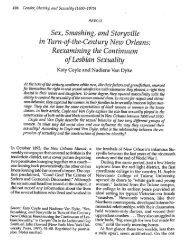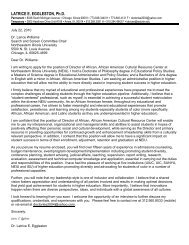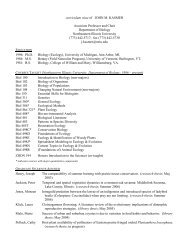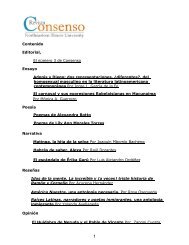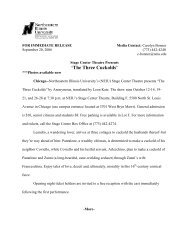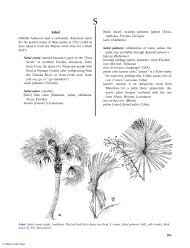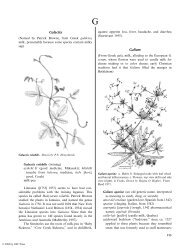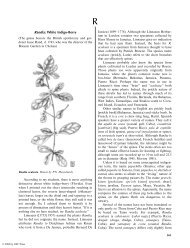Herba Cana - Northeastern Illinois University
Herba Cana - Northeastern Illinois University
Herba Cana - Northeastern Illinois University
Create successful ePaper yourself
Turn your PDF publications into a flip-book with our unique Google optimized e-Paper software.
© 2004 by CRC Press<br />
552 Florida Ethnobotany<br />
Pterocaulon pycnostachyum. Drawn by P.N. Honychurch.<br />
looked more closely, he realized that there were two<br />
different species. One species grew in the southeastern<br />
states (North Carolina to Florida, west to Mississippi),<br />
and the other in Texas, eastern Mexico, and the<br />
West Indies. The species name virgatum had already<br />
been applied to the western species, so Michaux called<br />
the one in the southeast Conyza pycnostachya (pycno,<br />
thick, stachyo, spike, in reference to the flower cluster).<br />
Then, in 1823, Stephen Elliott moved the species to<br />
Pterocaulon to create the name used now, Pterocaulon<br />
pycnostachyum. Later, in 1836, Augustin-Pyramus de<br />
Candolle moved virgatum to create the name Pterocaulon<br />
virgatum for the western species.<br />
Both species have long been called blackroot or<br />
Indian blackroot in the United States, but they sometimes<br />
also are called rabbit tobacco. The last name is<br />
more often applied to members of Gnaphalium, the<br />
genus where Linnaeus originally put these plants. Our<br />
word tobacco came into English from Spanish tabaco,<br />
first used in the 1500s but taken from a Taino word in<br />
Hispaniola. The modifier ‘‘rabbit’’ is equivalent to<br />
saying ‘‘wild’’ to distinguish it from the cultivated<br />
Nicotiana. Comparison with Nicotiana results from<br />
Pterocaulon leaves being smoked or chewed either as a<br />
medicine or simply because tobacco was not available.<br />
The western species, P. virgatum, has a richer<br />
history of common names than the eastern plants,<br />
surely because that species is geographically spread<br />
from Texas to Argentina, and in the Caribbean. It<br />
too is called blackroot or Indian tobacco in the United<br />
States. However, Jamaicans call it golden cudweed.<br />
That Jamaican name is based on the Old English<br />
cwidu or cudu, which is sometimes also rendered quid.<br />
Those words date from about A.D. 1000 and refer to<br />
any plant substance that is held in the mouth and<br />
masticated, but not swallowed. Typically, after the<br />
introduction of Nicotiana into the Old World, the<br />
‘‘cud’’ has been synonymous with that species. However,<br />
the practice of chewing a cud is much older in<br />
Europe than knowledge of the American Nicotiana.<br />
Other people were more impressed with the looks<br />
of the aboveground parts of these plants. Due to the<br />
white pubescence, people call them branqueja (the<br />
white one, Brazil), calça de velho (old man’s shoes,<br />
Brazil), or oreille mouton (sheep’s ear, Martinique,<br />
Dominique). Pterocaulon is called langue à vache<br />
femelle (female cow’s tongue, Martinique, Dominique)<br />
to distinguish it from langue à vache, which is<br />
Elephantopus. Because the plants retain their shape<br />
and color when dried, they are also called siempreviva<br />
(everlasting, Cuba). References to where one may find<br />
the plants are in some names*/alecrim das paredes<br />
(rosemary of the walls, Brazil), travesera de loma<br />
(crosser of hills, Cuba), and vela de sabana (savana<br />
candle, Dominican Republic). Allusions to the potent<br />
chemicals contained in the herbs are barbasco<br />
[verbasco] (a fish poison, Brazil) and cura nacío (cures<br />
at birth, Dominican Republic).<br />
The eastern P. pycnostachyum has names only in<br />
English and in two Seminole languages. Sturtevant<br />
(1955) found literature with various spellings of these<br />
names back to the 1930s, and then wrote that<br />
Mikasuki picikcalah kayikcî meant ‘‘blood saver<br />
medicine.’’ That is the same sense as pechekche alahke<br />
aayek that the modern Mikasuki speakers translate<br />
more exactly (pechekche, blood, alahké, leftover,<br />
ayekche, medicine). ‘‘Blood medicine’’ is the Mikasuki<br />
name pechekche emayekche recorded by Snow and<br />
Stans (2001).<br />
Williams ([1837] 1962) may have been the first<br />
person to record that this plant was used by the<br />
Seminoles. He wrote that it was ‘‘[t]he famous Indian<br />
remedy for pulmonary disorders.’’ Sturtevant (1955)<br />
later recorded that the Seminoles used these plants<br />
widely in medicines where there was a real or perceived<br />
problem with the blood. The plant was used to treat<br />
chronic sickness, coughs and colds, ‘‘Cow Creek<br />
Sickness,’’ fever, menstrual difficulties, ‘‘Otter Sickness,’’<br />
and was used in childbirth. Modern Seminoles





